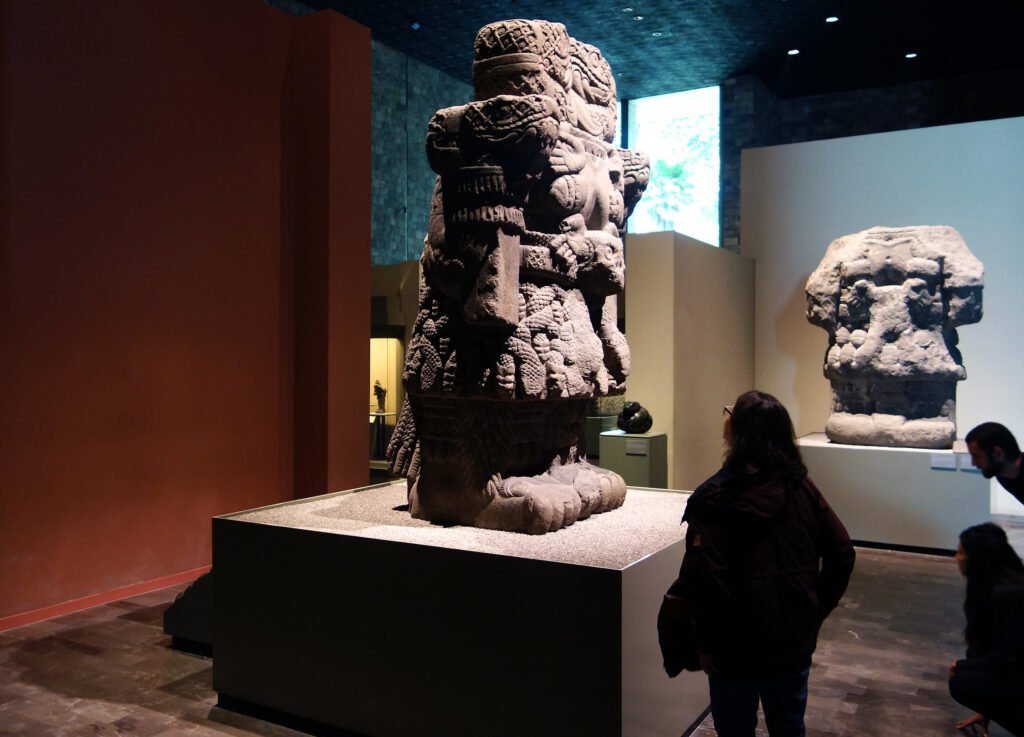In the intricate pantheon of Aztec mythology, few deities embody the multifaceted nature of existence quite like Cōātlīcue. This ancient goddess is associated with fertility, creation, and death, encapsulating the cycle of life in all its complexity. Her name, which means “skirt of snakes,” reflects her unique appearance as a woman wearing a garment made of writhing serpents. Additionally, she is known as Tēteoh Īnnān, or “mother of the deities,” underscoring her role as the mother of all gods. In this article, we will delve deep into the story and symbolism surrounding Cōātlīcue, exploring her significance in the Aztec pantheon and her enduring impact in Mexican culture.
The Story of Cōātlīcue
The Birth of Huītzilōpōchtli
One of the most intriguing aspects of Cōātlīcue’s story is the birth of her most famous offspring, Huītzilōpōchtli. According to ancient lore, Cōātlīcue becomes pregnant after being impregnated by a ball of feathers. In an astonishing turn of events, Huītzilōpōchtli emerges fully grown and armed for battle immediately after Cōātlīcue’s decapitation. This version of the story emphasizes the role of Huītzilōpōchtli as a protector and warrior.
However, an alternative rendition suggests that Huītzilōpōchtli is the child conceived in the ball-of-feathers incident and is born in time to shield his mother from harm. This version highlights the bond between mother and child and their intertwined destinies.
The Attack of Coyolxauhqui
In the narrative surrounding Cōātlīcue, her daughter Coyolxauhqui plays a significant role. Coyolxauhqui leads an attack on their mother, gathering four hundred siblings to participate in the assault. However, Huītzilōpōchtli valiantly fights back, slaying many of his brothers and sisters. He ultimately decapitates Coyolxauhqui and hurls her into the sky, where she transforms into the moon. This episode illustrates the eternal struggle between light and darkness, and the triumph of one’s destiny in the face of adversity.
The Cōātlīcue Statue
At the National Museum of Anthropology in Mexico, the imposing Cōātlīcue statue stands as a testament to the veneration of this goddess. The statue depicts Cōātlīcue with her serpentine skirt, a visual representation of her transformative powers. This manifestation of the goddess aligns with the myth of the creation of the present Sun, in which Cōātlīcue and other women sacrifice themselves, and their skirts are worshipped by the Aztecs. The statue serves as a tangible connection to the mythological heritage of the Aztec civilization.
Symbolism and Meaning of Cōātlīcue
Duality of Life and Death
At the core of Cōātlīcue’s symbolism lies the duality of life and death. She represents the eternal cycle of creation and destruction, embodying both a creator and a destroyer. Through her association with fertility and the earth deity Tlaltecuhtli, Cōātlīcue signifies the cyclical nature of life and regeneration. She symbolizes the ever-present cycle of birth, life, death, and rebirth, reminding us of the inevitable passage of time.
Worship and Importance of Cōātlīcue
Worship in Aztec Religion
Cōātlīcue held a significant position in Aztec religious practices. She was worshipped as a mother goddess, with devotees seeking her protection and blessings for fertility. In order to appease her and ensure the continuation of life, human sacrifices were believed to be necessary. The veneration of Cōātlīcue highlighted the deep-rooted connection the Aztecs felt toward their land and the life it sustained.
Influence in Modern Culture
The influence of Cōātlīcue extends far beyond the realms of mythology. Her imagery continues to hold great importance in Mexican culture today. In various art forms, such as paintings, sculptures, and murals, Cōātlīcue represents Mexican identity and indigenous heritage. Moreover, she is a prominent figure in literature, inspiring authors and poets to explore her complex nature and the rich tapestry of Aztec mythology she represents. Religious festivities also incorporate Cōātlīcue, infusing ancient beliefs into contemporary traditions.
Conclusion
Cōātlīcue, the serpent-skirted goddess, stands as a testament to the depth and intricacy of Aztec mythology. As the embodiment of fertility, creation, and death, she embodies the very essence of life’s duality. Her mythology and symbolism continue to captivate and inspire, resonating with modern audiences and showcasing the enduring power of ancient belief systems. The worship and veneration of Cōātlīcue have left an indelible mark on Mexican culture, ensuring that her legend lives on for generations to come.
